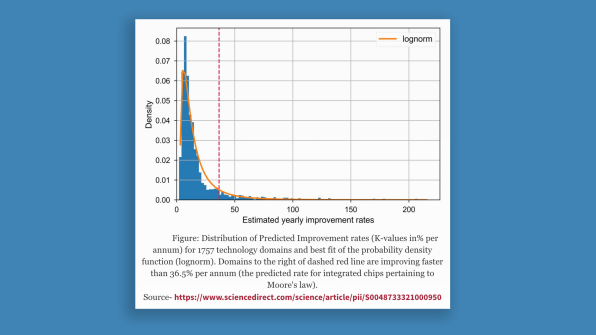Software. Batteries. Lasers. Let’s go.
The phone in your pocket has 100,000 times the processing power of the Apollo 11 guidance computer that landed us on the moon. That’s thanks largely to the 1965 prediction now known as Moore’s Law, or the dependable principle that processor speeds will double every two years.
As a result, this $200,000 computer from the ’60s is vastly outperformed by the cheapest smartphone you can buy today. And whole industries can project the future of their business by depending on this ever-increasing computer power.
But what about everything else? Is there any way to predict the improvements coming to other technologies, ranging from displays, to electric motors, to farming equipment?

Now there is, thanks to researchers at MIT. They’ve built the equivalent of a Google search for innovation. Using their online search engine, you can type in one of 1,757 different technologies, and get one sharp number, which is its expected rate of improvement each year.
Mechanical hair removal sees a 2% improvement each year. Glass offers an 11.4% rate of improvement. Batteries offer a 13.3% rate of improvement. Semiconductors (like processors) offer a 42.6% rate of improvement (that’s the rate of Moore’s Law). Whatever you want to look up, you can literally type it in and get a snapshot of how quickly this technology is expected to improve.
But why do researchers think they have these predictions right?
The system was developed by an MIT team that studies a surprisingly niche field: innovation itself. The school’s research began when MIT professor of practice Christopher Magee retired from Ford after working for 35 years as an engineer and designer. Following a decade of personal research on innovation at MIT, Magee began enlisting grad students, including Anuraag Singh, to study the topic, too. (Before he got into research, Singh worked inside Honda’s own R&D lab, and was tasked with figuring out which technologies needed long-term investment.)
Behind the search tool they built lives a complex AI model that scans the U.S. patent system to build its predictions.

“The number of patents in an area doesn’t predict improvement,” explains Magee. “What we’re relying on are citations.”
Like scientific research papers, patents routinely reference other patents. The AI—developed and validated by Giorgio Triulzi, assistant professor at Universidad de los Andes—can build a whole networked web of these patent relationships, seeing not just which are influential within their own fields, but also which are pulling from completely disparate fields. As Magee explains, semiconductor patents alone don’t explain their improvement over time, because the most successful fields dip into other research topics. In the case of semiconductors, improvements in lasers actually improved chips in the past, and the team believes new plasma research will in the future. Similarly, patents in software are now being cited by all sorts of patents in other industries, because so much of the world is operated digitally.
“It’s really hard to actually trace everything,” explains Magee, noting that with every link in the patent chain, you reach more and more referential patents. These references “explode” outward as you go, he says. But the AI pulls clear innovation projections out of all of these relationships.
The team created the patent search tool because it was the most practical means to look up over 1,000 different technologies—which makes it a superb tool for R&D teams and other future-casting groups in the public or private sector. Any other sort of graphic interface or list would be unwieldy. When you type your technology into the search box, it will pull up its innovation rate, along with the top 10 most-cited recent patents about it.
This search tool isn’t pretty, but it’s powerful. You can get an instantaneous snapshot of how things are going in almost any technological field because every search gives you a number. Singh jokes that if he’d had this tool before going to college, he never would have pursued mechanical engineering, since its technologies improve only a few percentage points a year. Software engineering with a 100%+ rate of improvement would have been far more ambitious as a career path.
But what do these percentage innovation rates actually mean? Let’s go back to that idea of batteries, which are generally improving at 13.3%. (I say generally only because the research team admits it’s grouped many battery technologies together, and is considering breaking them out so you can compare lithium ion to nickel cadmium. Lithium ion, in electric cars and smartphones, is improving faster than AA batteries in your TV remote.)
For batteries, that 13.3% could reference anything being explored in these patents—like watts per square centimeter, or the watt hours stored per dollar of investment. So yes, the figure is tied to performance. But no, it’s not always clear what that performance means, and the tool offers no way to drill down into more specific analyses.
Meanwhile, when you cross-reference batteries against combustion engines, which have about a 7% to 8% rate of improvement, you get a very quick explanation as to why it’s taking so long for electric cars to catch on, according to Magee. It’s not that electric technology isn’t better than combustion. It’s that it’s still only a bit better, and only improving a bit faster (5% per year). Magee says we saw a similar slow transition in American factories, circa 1900. Many factories didn’t go electric for decades, since other technologies like steam were already there and working pretty well.
One additional challenge to understanding what these rates of improvement actually mean is that, long term, many fields are improving too fast to conceptualize.
Think about a 20% annual improvement in any field as you would a compound investment. If you start with $100 in a bank account, and you get a 20% return on that investment every year, you will have nearly $1 million after 50 years. Gains build upon gains. Compound investment leads to logarithmic growth (think: the rapid spread of bacteria across a cell culture), and the same is true to innovation.
“It’s hard to imagine what a million times better would be like; that will lead to things you can’t imagine at all,” says Singh.
While the search tool won’t do much to fill in these gaps in your imagination, Singh and Magee have launched a company called Technext to help organizations peek into the future with more granularity, to help them understand when to invest in certain technologies, and by what year one technology may outpace another.
Their first customer? The U.S. Air Force.



